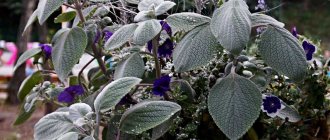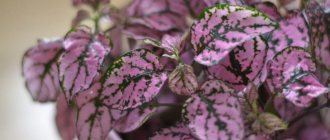Features of care
In order for the carnation to please the eye with its lush and bright blooms (photo), it is necessary to provide it with the most comfortable conditions. Caring for a houseplant at home involves loosening the soil, timely watering, fertilizing and cutting off wilted inflorescences.
On a note!
Before starting to grow this amazing, pleasantly smelling plant, every gardener, especially a beginner, needs to familiarize himself with information on how to care for carnations at home.
Possible problems in growing
To avoid problems in the future and maintain the health of the flower, it is necessary to constantly monitor its condition and changes in appearance and behavior.
Hybrid indoor carnation
Here are some rules:
- If the plant refuses to bloom or grow, you need to check whether it has enough light in the room.
- The crop turns yellow and dries out - the result of poor-quality soil. The plant should be transplanted into another soil, but first treat it with potassium permanganate.
- There is a white coating on the back of the leaves, flowering has deteriorated, and the shoots hang down - the flower has been affected by pests such as spider mites, aphids, and powdery mildew. In this case, the leaves are washed with a soap solution, then the plant is sprayed with an infusion of tansy or celandine.
Attention . If folk remedies do not help in pest control, insecticides are used.
Home flower bed made from indoor carnations
With properly selected lighting, watering and fertilizing, indoor carnations grow and develop well, rarely get sick, and adapt to the new soil after transplantation without any problems. By combining different varieties, you get a wonderful creation of beautiful flowers and the greenery that surrounds them.
Lighting
Carnations are also demanding regarding lighting conditions. The flower should receive natural light at least five hours a day. But at the same time, it is necessary to protect the plant from sunlight, otherwise the carnation will get burned.
If for some reason it is not possible to provide an influx of sunlight for a longer period of time, it is recommended to use artificial lighting. Otherwise, the plant’s growth will slow down, the leaves will begin to become smaller, and the flowering will be short and sluggish.
What to do after buying a plant
Transportation consists of simply securing the pot with carnations so that it does not fall and the delicate inflorescences do not break. Those. if it’s convenient, just hold the flower in your hands.
Be sure to transplant the plant into a pot 2-3 cm wider and deeper. When removing the cloves, be careful not to damage the roots, or better yet, replant them together with all the soil from a store pot, this will cause minimal harm to the plant. Be sure to make a drainage layer of expanded clay to drain excess moisture and aerate the soil.
Humidity and watering
For rapid growth and the formation of healthy flower stalks, it is recommended to regularly spray using settled warm water. You can also water the bushes with it.
On a note!
Indoor carnation is a moisture-loving flower, so it needs regular and abundant watering, this is especially true during the period of active growth, budding and flowering.
In addition, caring for indoor carnations at home requires compliance with the following rules. Monitor the condition of the soil in the container with the flower, do not allow it to dry out.
When and how does it bloom
Indoor hydrangea - home care
There are more than 3 hundred types of cloves. Some are cultivated indoors. Among them there are decorative and hybrid species. Household crops are annual or perennial.
Attention! To create a beautiful flower bed on the windowsill, seeds of different varieties are placed in one container.
Flowering period
The usual time for flowering to begin is 3-4 months after planting in a pot. Flowering continues from early spring until frost, depending on the type of carnation. The flowers do not fade for a long time and retain their aroma and freshness for about 5 weeks. If the carnation is planted in the fall, it will bloom within six months. To extend the flowering period, dried flowers are removed.
Double Chinese carnation
Types of flowers
Compact types of home carnation flowers are selected, for example:
- The Chinese species is an annual with creeping stems, the height of which is 25–30 cm. The flowering period is June–October. Flowers are white, red, pink or lilac, with patterned petals and jagged edges.
- Turkish or Bearded Carnation is a biennial crop. The stems are branching, 20–25 cm high. Flowers are 1 cm in diameter. Double or simple. The inflorescences are 12 cm in diameter. It blooms in the second year from planting. In the third year, the cloves are disposed of.
- Dutch or Garden variety. Only the Grenadine variety is grown indoors. The culture is perennial, grows up to 40 cm, blooms in the second year from February to late autumn. The flowers are simple or double, pink, white, variegated, yellow and red.
- Hybrid low, up to 20 cm. Graceful flowers with dissected petals and a wonderful aroma.
- Indian is an evergreen low bush with shiny leaves, white flowers and inflorescences of 10 buds. The buds have 5 petals and a pleasant smell.
Turkish indoor carnation
In addition to these species, Shabot carnation blooms until late autumn. Growing Shabot cloves from seeds at home is impossible. This is a garden option and comes indoors only with the onset of cold weather, when Shabot is dug out from the site, planted in a pot, then transferred to the house, where it blooms until mid-November.
Carnation Shabo
Feeding
Twice a month, when the plant is in the phase of active development, it is necessary to support it with fertilizers. To do this, it is recommended to purchase special formulations with a high potassium content.
On a note!
Fertilizer can be diluted with both water and milk. The resulting solution is sprayed onto the soil in the flower pot, avoiding contact with the flowers and leaves. The first procedure can be carried out a month after sowing the seeds.
General description of the flower
Indoor carnation is a plant on which buds appear during the growing season, and then bright flowers; there are knotty swellings on the stems. The shoots are small in size, the leaves are narrow in size, dark green in color. The surface of dianthus petals can be simple or terry.
The flowers come in white, pink, and red shades. Blooms for a long time - from early summer to autumn. In order for the flowering to be abundant, it is recommended to remove dry petals in time. In October, clove seeds begin to be collected.
Transfer
Since cloves are grown as annuals, they do not require replanting. Therefore, we can only talk here about methods of propagating the variety you like.
The main and most common method of propagating carnations is by sowing seeds. To do this you need to do the following:
- pour water into the hole (when sowing dry seeds);
- place planting material there, planting depth - no more than 1 cm;
- sprinkle with soil;
- moisten the soil using a spray bottle;
- cover the container with a polyethylene cap.
Important!
The film should be opened slightly several times a week - this will allow the sprouts to gain access to oxygen. The soil in the greenhouse must be periodically moistened until seedlings emerge. This will happen in about 2 weeks.
A month later, young plants should be planted in pots at a distance of at least 5 cm from each other. To propagate carnations, you can also use the cutting method. Cuttings are taken only after flowering has ended.
Home care
Choosing a location and lighting
The plant is extremely light-loving, but in the open sun the delicate leaves can burn. If possible, try to place the pot of carnations on a window facing south or southwest . This way you will extend the daylight hours and get excellent flowering. In winter, it is recommended to use light lamps. If there is a lack of light, the flowering of the carnation will not be lush and durable, and the leaves will become thin and pale.
The soil
Carnation grows well in sandy soils with the addition of turf, humus, peat, wood ash and fertilizers. You can make your own, but a ready-made soil mix will also work. The soil in the pot should not be compressed, but loose. This is the key to a strong root system of the plant.
Temperature and humidity
Carnation grows well at temperatures from 15 to 35°C . But it will reveal all its beauty better at 20-25°C . Optimum humidity 60-75% . But depending on the temperature it is necessary to adjust the humidity. So at cooler temperatures (12-15 °C) additional humidification is not required. And if it’s hot, the plant needs to be watered and sprayed more often in the morning and evening. Between sprayings, place a container of warm water near the plant to maintain optimal humidity.
Watering
The main features of watering carnations are warm water and moderation . The soil in the pot should be constantly moist, make sure that the soil does not dry out, but also do not allow excessive watering. If you water the plant with cold and unsettled water, it will not die, but it will not delight you with lush flowering and a healthy appearance either.
Trimming
In order for the plant to reveal itself in all its glory, proper watering, fertilizing and pruning are important. To increase the flowering period, it is important to remove fading buds, then the plant will not waste energy on ripening the seeds, but will send them to new inflorescences. And if you want the bush to look symmetrical, you need to pinch the side shoots. No pruning is required in winter.
Feeding and fertilizers
During the dormant period, the plant does not require feeding. But with the onset of the active phase of growth and flowering, fertilizers must be applied 2 times a month . Choose liquid mixtures with a high content of potassium and phosphorus. Without the use of fertilizing, the carnation will bloom, but not so vigorously and for a long time. If you apply fertilizer more often, the plant will grow too much and will have to be pruned more often.
Bloom
Carnations bloom from March to October . The palette is very wide: white, red, pink, yellow, crimson, purple, etc. Just imagine what beauty you can grow on a windowsill! Flowers are collected in inflorescences and may vary depending on the species:
- According to the number of petals - double, semi-double and simple.
- By color - single-color and two-color.
- The shape of the petals is with a jagged and smooth edge.
Transfer
Only perennial carnations are replanted. To do this, you need to select a soil. The easiest way is to buy ready-made soil mixture for carnations . The ideal substrate is a mixture of peat, turf, and leaf soil in a 1:2:1 ratio.
You can take any pot, clay or plastic, the main thing is its size - 2-3 cm wider and deeper than the store-bought one. When replanting, be sure to make a drainage layer of pebbles or expanded clay, this prevents moisture stagnation. To avoid damaging the roots of the plant, replant together with a lump of earth. Finally, water the cloves a little.
Features of care depending on the time of year
Winter is the dormant period for indoor carnations. By this time, the plant has completely bloomed, so dried flowers and buds should be removed.
If a particularly bright variety is selected, fluorescent lamps should be turned on periodically for additional illumination. During the dormant period, it is necessary to stop fertilizing the soil, as well as “bathing” the plant. During this period, all processes slow down, and the plant does not require special attention.
Indoor cloves: varieties and types
The following varieties of carnations are most suitable for indoor growing:
- Chinese carnation. This plant is distinguished by a variety of shades of petals with corrugated edges: from white to red. Also, the petals can combine two colors at the same time. The stem of the carnation is creeping. Carnation belongs to the group of annual plants.
- Turkish cloves. It stands out among other varieties in that its buds are collected in shield-shaped inflorescences, 8-12 cm in diameter. Like the Chinese carnation, it has corrugated edges. Turkish carnation also has a large number of shades. Another distinctive feature of this variety is its undemandingness to sunlight.
- Hybrid carnation. Typically, gardeners prefer this variety. Hybrid carnation is one of the annual plants; its height reaches 20 cm. During the flowering period, the plant is completely overgrown with large bright buds.
- Clove grenadine. One of the types of garden carnations that is well suited for growing at home. It is easily recognized by its large terry buds with corrugated edges.
All of these plants belong to the class of annuals.
How to grow perennial carnations: methods of planting seeds
You can sow cloves either directly in open ground or as seedlings. The difference lies in the timing of sowing, because the garden can be planted no earlier than the frosts have passed. In addition, bushes grown by direct sowing will increase the above-ground part in the first year. The first buds will appear only next season. But some varieties, for example, grass carnations planted through seedlings, will give a test flowering already in the year of planting.
Recommendations and possible problems
When growing double Chinese carnations from seeds, it is recommended to follow a few simple recommendations. In particular:
- do not use fresh organic matter to feed crops when growing;
- do not plant bushes too close, otherwise they will interfere with each other’s development;
- do not neglect monthly fertilizing - when grown on poor soil, Chinese carnation does not set buds well.
If you do not plan to use specific bushes for harvesting planting material, it is better to remove ripening seed pods immediately after appearance. Otherwise, the plant will direct resources to reproduction and stop producing buds.
Plant diseases
It is extremely rare for carnations to get sick; this usually happens during heavy rainfall, as the soil becomes too wet.
Alternaria blight can affect carnations, causing black or brown spots to appear on the leaves and stems.
Another popular disease is rust, the name speaks for itself; red spots appear on the back of the leaves.
If you notice any disease, immediately remove the plant and water the planting site with a disinfecting solution.
Carnation rust
In case of viral diseases, the plant begins to slowly die; the cause of such diseases can be pests or untreated garden tools. In order to prevent the spread of the disease, it is necessary to get rid of the diseased plant.
In order to prevent the appearance of any plants, it is necessary to disinfect the seed, soil and container for planting. Also, treat plants against pests and remove weeds in a timely manner.
Step-by-step photo instructions for sowing Shabot cloves for seedlings
If you know all the rules, nuances and secrets of planting, you can grow good and strong seedlings that will delight you with their beautiful flowering in the future. Next, you will find a master class on sowing Shabot carnation seeds for seedlings with step-by-step photographs.
Selection of capacity
To sow garden clove seeds, you can use a common container (plastic box, some kind of bowl) or individual containers (plastic cassettes, cups, peat pots, cups). The main thing is that the container is not very high (no more than 6 centimeters) , since excessive soil moisture can cause sluggish seedlings or their absence. should also to remove excess moisture!
Advice! Before sowing seeds, it is recommended to disinfect the containers. For example, pour boiling water or a solution of potassium permanganate (potassium permanganate).
Seed selection and preparation
To choose high-quality Shabot carnation seeds for seedlings, you can follow the classic scheme - simply buy seed from a trusted manufacturer with a good reputation. The package with seeds must contain complete information : name of the variety, brief information about it, information about the manufacturer, expiration date, contact information, timing of sowing seeds, planting in open ground, flowering time.
Advice! You should be wary of the fact that the price is too low - it is better to buy expensive seeds or those in the mid-price segment, because you don’t know what surprises you can expect from seeds that are too cheap.
Before sowing, it is recommended to soak the seeds in a growth stimulator, for example, Epin or Zircon for 2-4 hours.
As you can see in the instructions, for preparation you need to mix 0.05 ml (2 drops) of Epin-Extra solution and 100 ml of water.
To prepare the Zircon growth regulator, you need to dilute 0.025 ml (1 drop) of its solution in 100 ml of water.
Also, as a preparation for seeds before planting, you can germinate them on cotton pads.
Just put the discs on some kind of plate. Moisten the discs.
Place seeds on them.
Cover with another disc on top and moisten again.
Place the seed disks in a plastic bag and place in a warm place. It takes 2-3 days to germinate.
By the way! You can collect seeds yourself, for example, if it grows on you or your friends. The seed remains viable for up to two to three years.
Soil preparation
, light and loose soil with neutral acidity is preferable
You can prepare your own soil mixture at home. To do this, mix the following ingredients:
- soil from the garden or turf soil (1 part);
- peat (1 part);
- humus (1 part);
- clean river sand (0.5 parts).
Or you can buy a universal soil for flower seedlings, but add perlite to it to improve the structure (as in the photo):
Direct sowing
So, if you have prepared the soil mixture, containers, and seed, then it’s time to move on to planting. Below are step-by-step instructions with photographs for sowing Shabot carnation seeds for seedlings:
- Place drainage at the bottom of the container. For example, perlite, broken brick, pebbles, expanded clay (pictured). Layer thickness is 1-1.5 centimeters.
- Fill the container with soil (there should be a very small distance between the edges of the container and the surface of the ground).
- Lightly compact the soil with your hand.
- Now you need to carefully water it using a syringe.
- When the water is absorbed, you need to make grooves (the most convenient way to do them is with a ruler), the distance between them is 3 centimeters, and the depth of the grooves is 3 millimeters.
Even cups and plastic cassettes can have grooves in the middle.
- Now we move on to the important step - sowing Shabot garden carnation seeds for seedlings. To do this, place the seeds in grooves, the gap between the seeds is 2 centimeters.
You can simply sow with your fingers.
Or you can use a toothpick dipped in water.
- Now you need to sprinkle the seeds on top with calcined river sand. The layer thickness is no more than 2-3 millimeters (sand will prevent blackleg, which the crop is susceptible to).
- Then you need to spray the surface of the soil with a spray bottle, but you can only water it with settled, clean water.
- Create a mini-greenhouse - just cover the container with glass, a lid or film. And sign on top as you wish.
- Move the container to a warm place where the temperature is maintained at 18-20 degrees Celsius.
When to sow clove seeds for seedlings, in what month
If you decide to grow a wonderful flower, then you probably have a question - when is it better to plant Shabot carnation seeds for seedlings, in what month? The optimal sowing time is from mid-January and February (but some summer residents also sow in early March) . You should not choose a time that is too late, because young plants need a lot of time for normal development.
Pay attention to climatic features in different regions, for example, in the middle zone (Moscow region) you can plant in mid-February, in the Southern regions - the second half of January, in the Leningrad region, Siberia and the Urals - early March, in the Volga region - the first half of February .
You can also choose the right time to plant Shabo carnations using the 2022 Lunar Calendar:
- Favorable days for the procedure: in January: 1, 10, 11, 15, 16, 19, 20;
- in February: 7, 8, 12, 13, 14, 15;
- in March: 10, 11, 15, 20, 21, 24, 25.
- in January: 2, 18th;
Pests and control methods
Let's look at what pests indoor carnations have and how to combat them:
Spider mite . It is distinguished by its gluttony and rapid reproduction. Settles on the underside of the leaf. If you find brown or pale yellow damage on the leaves, you need to act immediately. For minor damage, you can use a soap solution, which is applied only to the above-ground part of the plant. Make sure that the soap does not get into the soil. In case of severe damage, only chemical herbicides will help, such as fitoverm, appolo, vermitek, etc. They must be used in strict accordance with the instructions.
Aphid . It multiplies quickly and feeds on plant sap. You can fight it in several ways:
- Chemical . Various herbicides are used (actara, fitoverm, kinmixi, etc.).
- Biological . Catch a few ladybugs on the street, they will eat all the aphids and save your plant.
- Ecological . Remove all affected areas of the plant. Treat with soapy water. People's Treatment with soda, soap solution, extracts of various plants.
All the methods presented are effective against aphids on carnations.











